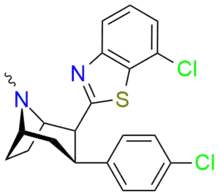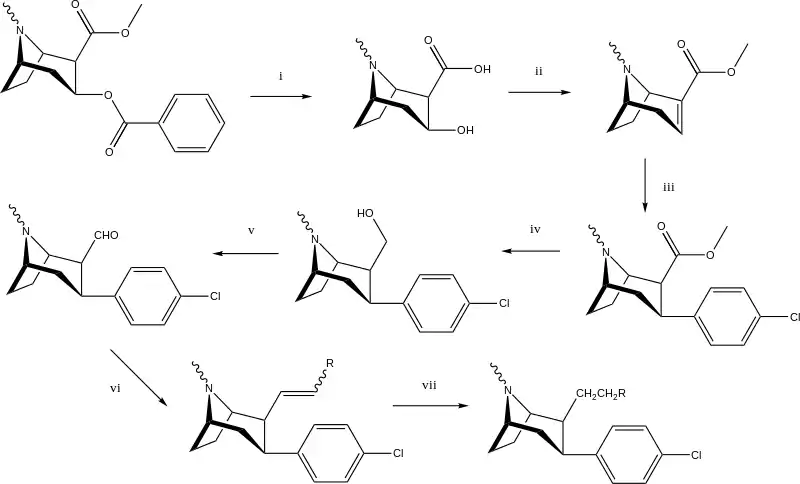RTI-31
(–)-2β-Carbomethoxy-3β-(4'-chlorophenyl)tropane (RTI-4229-31) is a synthetic analog of cocaine that acts as a stimulant.[1] Semi-synthesis of this compound is dependent upon the availability of cocaine starting material. According to the article,[1] RTI-31 is 64 x the strength of cocaine in terms of its potency to elicit self-administration in monkeys. WIN 35428 was 6 x weaker than RTI-31, whereas RTI-51 was 2.6 x weaker than RTI-31.
 | |
| Identifiers | |
|---|---|
| |
| CAS Number | |
| PubChem CID | |
| ChemSpider | |
| CompTox Dashboard (EPA) | |
| Chemical and physical data | |
| Formula | C16H20ClNO2 |
| Molar mass | 293.79 g·mol−1 |
| 3D model (JSmol) | |
| |
| |
| | |
A further advantage, in addition to potency of this compound, is that its duration of activity is longer than for cocaine. It could therefore be considered within the context as an agonist based therapy for treating cocaine addiction, although it is actually RTI-336 that entered into clinical trials with this in mind. RTI-31 is already completely psychoactive in its own right meaning that further chemical manipulation should be viewed as an option that is not strictly necessary. RTI-336 is actually made using RTI-31 as starting material. RTI-31 is not an entirely selective DRI in that it also has appreciable SERT and NET blocking affinity. RTI-31 can easily be "cleaned" though, as is done, for instance, by replacing the carbomethoxy ester with a more sterically occluded substituent such as is done for RTI-113.
Binding and uptake selectivity
Based on the uptake of tritiated biogenic monoamine radiotracers it can be confirmed by observing the figures in the attached table that RTI-31 is a relatively balanced reuptake inhibitor wrt the D/N/S ratio.
The binding ligand affinities for the different transporters is skewed somewhat in favor of the DAT; there may be some bias in the data. The reason for this could be that WIN35428 is relatively easier to displace from the DAT versus paroxetine from the SERT, because of the higher binding constant of the former compound.
Also it needs to be borne in mind the idea of transporter promiscuity.[2] It may be possible that the NE levels are raised, at least in part, through DAT blockade.
RTI-31 lies somewhere in the middle of the table between troparil on one end and RTI-55 on the other. It is not as selective as RTI-113 for the DAT, but is more selective than Dichloropane is for this transporter. RTI-31 also has some muscarinic acetylcholine agonist activity.
| MAT IC50 (and Ki) for simple phenyltropanes with 1R,2S,3S stereochemistry.[3] | ||||||
| Compound | [3H]CFT | [3H]DA | [3H]Nisoxetine | [3H]NE | [3H]Paroxetine | [3H]5-HT |
| Cocaine[4] | 89.1 | 275 cf. 241 | 3300 (1990) | 119 cf. 161 | 1050 (45) | 177 cf. 112 |
| Troparil | 23 | 49.8 | 920 (550) | 37.2 | 1960 (178) | 173 |
| WIN 35428 | 13.9 | 23.0 | 835 (503) | 38.6 | 692 (63) | 101 |
| RTI-31 | 1.1 | 3.68 | 37 (22) | 5.86 | 44.5 (4.0) | 5.00 |
| RTI-113[5] | 1.98 | 5.25 | 2,926 | 242 | 2,340 | 391 |
| RTI-51 | 1.7 | ? | 37.4 (23) | ? | 10.6 (0.96) | ? |
| RTI-55 | 1.3 | 1.96 | 36 (22) | 7.51 | 4.21 (0.38) | 1.74 |
| RTI-32 | 1.7 | 7.02 | 60 (36) | 8.42 | 240 (23) | 19.4 |
Data in Above table from rats brains (1995). More recent work has advocated using cloned human transporters.
Additional Analogs
RTI

- Nor-RTI-31 is called RTI-110.[7]
- Reduced ester to alcohol is called RTI-93.
- Acetylated alcohol is called RTI-105.
- Benzoyl alcohol is called RTI-123.
- RTI-145 is a methyl carbonate of the alcohol.
Conversion of ester in RTI-31 to heteroaromatic nuclei also possible. E.g. RTI-470 was among the potent DRI known to exist, 0.094nM.
Kozikowski
Further chemical modification of RTI-31 leads to novel chemical entities; some of them are highly potent, and one of them has been reported as lasting for three days (z-chloro-vinyl analogue).[8][9]


(i)1 N HCl, reflux 15 h; (ii) (a) POCl3, reflux; (b) MeOH, 0 °C; (iii) 4-ClPhMgBr, Et2O, –40 °C; (b) –78 °C, 1.1 equiv TFA; (c) silica gel chromatography; (iv) DIBAL, toluene, –78 °C; (v) ClCOCOCl, DCM, –78 °C, DMSO, 30 min, TEA; (vi) Ph3P+CH2RBr−, n-BuLi, THF, room temp; (vii) H2, Pt/C. 40 psi, cyclohexane.
| R | X | [3H]mazindol binding | [3H]dopamine uptake |
| CO2Me | Cl | 0.83 | 2.85 |
| CH=CH2 | Cl | 0.59 | 2.47 |
| (E)-CH=CHCl | Cl | 0.42 | 1.13 |
| (Z)-CH=CHCl | Cl | 0.22 | 0.88 |
| (E)-CH=CHPh | Cl | 0.31 | 0.66 |
| (Z)-CH=CHPh | Cl | 0.14 | 0.31 |
| CH2CH3 | Cl | 2.17 | 2.35 |
| (CH2)2CH3 | Cl | 0.94 | 1.08 |
| (CH2)2CH3 | H | 1.87 | 1.61 |
| (CH2)3CH3 | Cl | 1.21 | 0.84 |
| (CH2)5CH3 | Cl | 155.7 | 271 |
| CH2CH2Ph | Cl | 1.46 | 1.54 |
This is because of the compounds increased lipophilicity. The act of changing a drug's duration of action through altering its lipophilicity is commonly observed and not limited to this one.
If read nocaine, interesting n-propyl group chosen,
Although no efforts have presently been made to “optimize” binding affinity at the DAT, the substantive activity found for the n-propyl derivative (−)-9 of 3 nM is remarkable; the compound is only about 10-fold less active than the best of the high-affinity tropanes in the WIN series.[10]
References
- Wee S, Carroll FI, Woolverton WL (February 2006). "A reduced rate of in vivo dopamine transporter binding is associated with lower relative reinforcing efficacy of stimulants". Neuropsychopharmacology. 31 (2): 351–62. doi:10.1038/sj.npp.1300795. PMID 15957006.
- Daws LC (January 2009). "Unfaithful neurotransmitter transporters: focus on serotonin uptake and implications for antidepressant efficacy". Pharmacology & Therapeutics. 121 (1): 89–99. doi:10.1016/j.pharmthera.2008.10.004. PMC 2739988. PMID 19022290.
- Carroll FI, Kotian P, Dehghani A, Gray JL, Kuzemko MA, Parham KA, et al. (January 1995). "Cocaine and 3 beta-(4'-substituted phenyl)tropane-2 beta-carboxylic acid ester and amide analogues. New high-affinity and selective compounds for the dopamine transporter". Journal of Medicinal Chemistry. 38 (2): 379–88. doi:10.1021/jm00002a020. PMID 7830281.
- Kozikowski AP, Johnson KM, Deschaux O, Bandyopadhyay BC, Araldi GL, Carmona G, et al. (April 2003). "Mixed cocaine agonist/antagonist properties of (+)-methyl 4beta-(4-chlorophenyl)-1-methylpiperidine-3alpha-carboxylate, a piperidine-based analog of cocaine". The Journal of Pharmacology and Experimental Therapeutics. 305 (1): 143–50. doi:10.1124/jpet.102.046318. PMID 12649362.
- Damaj MI, Slemmer JE, Carroll FI, Martin BR (June 1999). "Pharmacological characterization of nicotine's interaction with cocaine and cocaine analogs". The Journal of Pharmacology and Experimental Therapeutics. 289 (3): 1229–36. PMID 10336510.
- Carroll FI, Howard JL, Howell LL, Fox BS, Kuhar MJ (March 2006). "Development of the dopamine transporter selective RTI-336 as a pharmacotherapy for cocaine abuse". The AAPS Journal. 8 (1): E196-203. doi:10.1208/aapsj080124. PMC 2751440. PMID 16584128.
- Spealman RD, Kelleher RT (March 1981). "Self-administration of cocaine derivatives by squirrel monkeys". The Journal of Pharmacology and Experimental Therapeutics. 216 (3): 532–6. PMID 7205634.
- Kozikowski, Alan P.; Roberti, Marinella; Johnson, Kenneth M.; Bergmann, John S.; Ball, Richard G. (1 June 1993). "SAR of cocaine: further exploration of structural variations at the C-2 center provides compounds of subnanomolar binding potency". Bioorganic & Medicinal Chemistry Letters. 3 (6): 1327–1332. doi:10.1016/S0960-894X(00)80341-8.
- Kozikowski AP, Eddine Saiah MK, Johnson KM, Bergmann JS (August 1995). "Chemistry and biology of the 2 beta-alkyl-3 beta-phenyl analogues of cocaine: subnanomolar affinity ligands that suggest a new pharmacophore model at the C-2 position". Journal of Medicinal Chemistry. 38 (16): 3086–93. doi:10.1021/jm00016a012. PMID 7636872.
- Kozikowski AP, Araldi GL, Boja J, Meil WM, Johnson KM, Flippen-Anderson JL, et al. (May 1998). "Chemistry and pharmacology of the piperidine-based analogues of cocaine. Identification of potent DAT inhibitors lacking the tropane skeleton". Journal of Medicinal Chemistry. 41 (11): 1962–9. doi:10.1021/jm980028+. PMID 9599245.